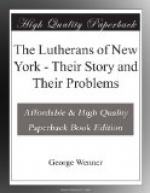“The churches have directly been engaged in Inner Mission work for a number of years, and now have three city missionaries constantly at work. The institutions conducted by this branch of the service are the Bethesda Rescue Mission at Woodhull St., Brooklyn, the Day Nursery at 46th St., Brooklyn, and an extensive industrial plant also in Brooklyn. Besides the Inner Mission has purchased land on Staten Island and erected a cottage there for a summer colony for poor children. The Norwegians of New York have also built a modern Children’s Home at Dyker Heights, Brooklyn. Although this is not owned by the church, but by a corporation of Norwegians, its constitution provides that the religious instruction should be based upon Luther’s Small Catechism. The Home is now taking care of sixty children, and is in charge of a Deaconess from the local mother house mentioned above. A new Inner Mission Agency was started two years ago when the late C. M. Eger bequeathed a large sum of money for the establishment of the Old People’s Home in connection with Our Saviour’s Lutheran Church. At present it is located in his former home, 112 Pulaski Street, and will, no doubt, be of great importance for our church work in the future.”
The statistics of the Scandinavian churches are presented in part in the following table. The figures of the first and second lines are taken from the United States Census of 1910. They include the children where one or both parents are of foreign descent. Those of the third line are obtained by deducting 10 per cent. from the number of Protestants, in the second line. The number of “souls,” fourth line, is the aggregate number of baptized persons, old or young, connected with or related to the respective congregations.
Swedes Norwegians Danes Finns Total 1. Population 53,464 34,733 13,197 10,304 116,698 2. Protestants 56,766 33,344 11,996 10,304 112,410 3. Lutherans 51,090 30,010 10,797 9,274 101,171 4. Souls 8,365 10,433 950 2,540 22,288 5. Communicants 3,829 2,152 422 840 7,643 6. No. of Churches 13 12 3 3 31
Prior to 1871 Germans were a negligible quantity in the political history of Europe. Divided into a multitude of tribes, with divergent interests, for centuries they had no political standing and were the football of the nations around them. From Louis XIV to the Corsican invader, except during the reign of Frederick the Great, their history was one of political incohesion and economic poverty.
Even in New York they were looked upon as aliens in the city which they had helped to found and where in three centuries their sons had stood in the forefront of the battle for freedom. The names of Jacob Leisler, of the seventeenth century, Peter Zenger of the eighteenth century, Franz Lieber and Karl Schurz of the nineteenth century are indelibly inscribed among the champions of freedom in America. Yet fifty years ago “Dutch” in New York had almost the same evaluation that “Sheeny” and “Dago” have today.




